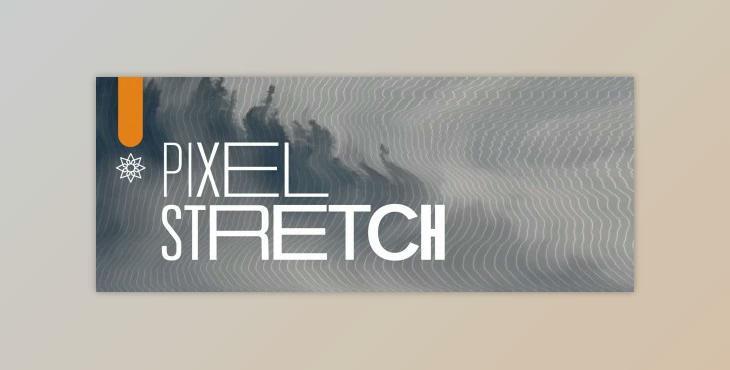Aescripts Pixel Stretch v1.6.0 (Win, Mac): Organic nonlinear subpixel stretching
How it works?
The brightness of pixels is used to stretch them. Pixels are stretched with subpixel precision. Each row or column is stretched cumulatively, meaning that each pixel offsets the next pixels along its line. This creates more organic patterns than simple effects such as "line stretch." This filter gives you more options than you would get with a simple effect like "line stretch."
Gfx plugin details of Aescripts – Pixel Stretch
The product is in the After Effects Plugins category from AeScripts, for more information about this post, you can click on the home page link in the sidebar.
To search for similar products to Aescripts – Pixel Stretch,
Does this product work on Windows and Mac OS? We mostly include the operating system in the title. If it is not written, it will work on Windows, and you can for the Mac version.
Use these hints
- The simple "line stretching" effect can be replicated by:
- Adjust the Stretch Start Offset according to the row/column
- Increasing Pixel Size and Pixel Stretch values to maximum
You can adjust the distribution mode and range to stretch the line more naturally.
- You can use more than one instance of the effect in the same clip/layer. Use Stretch Start Offset in conjunction with Distribution Mode or Range to modify only the desired area of an image.
- Edge Mode can be set to Transparent with Transparency Feather. This is useful for transitions. The same applies to Shading Opacity when the layer's transparency is set.
- Extend narrow images by applying the effect twice in each direction. Stretch Start Offset for both should be set to 60-80%, depending on the aspect ratio. Distribution Mode should be set to Linear Ramp up, Distribution Range to 0.1-0.2, and Pixel Stretch and Pixel Size values adjusted until the width is filled. You can experiment with different Stretch Curves or Stretch Curve Phases until you find the one that fits your image best.
The rundown of available parameters
- The direction determines towards which edge the stretching takes place.
- Intensity Source: Use a different layer in order to stretch the current layer. This is also known as a stretch mask.
- Pixel Stretch - The maximum length a pixel can grow. The default stretch curve adds 0 to the darkest pixels and the brightest pixels to the final length.
- Pixel Size is the base size of one pixel. Pixel Size is the final pixel size. Pixel Size + Pixel Stretch are examples. In the UI screenshot, it is 1 to 2.
- Stretch Curve describes how pixel brightness is used to determine the extent of stretching. Linear Ramp Up, which defaults to stretching dark pixels only, stretches bright pixels to the maximum amount. Linear Ramp Up is the opposite behavior. This chart shows all available mappings.
- The Stretch Curve Phase offsets the values of stretch curve mapping. For a more detailed explanation, please refer to the manual (downloaded with the plugin).
- Stretch Start Offset - This skips a portion of the image before pixel stretching begins.
- Distribution Mode- This mode determines how pixels are spread across the image.
- Constant - The stretching is uniform across the entire image.
- Linear Ramp up - The stretching gradually ramps up, starting with no stretching and ending at the Pixel Size + Pixel Stretch values.
- Linear Ramp Down: The stretching begins at Pixel Size + Pixel Stretch and slowly ramps down until there is no more stretching.
- The distribution range - determines how much of the image should suffer from stretching. The values between 0 and 1 have an effect on the width or height of the image (or vertically) when it is stretched. If you use Pixel Size less than 1, your image may be repeated. This is where values above 1 enter into play. 2. Infinity.
- Image Shift Phase: This phase offsets the image in the stretch direction.
- Image Shift Phase Synchro - When shifting an image using the Image Shift Phase, the luminosity values are picked from the shifted (on) image or the original (off) image.
- Overshading patterns are created by blending shading overlays onto the stretched image.
- The shading interval size is used to determine how thick the shading patterns are.
- Shading Interval Phase: This phase offsets the shading pattern.
- You can choose whether the shading channel(s) DIMMs the image (RGB) or the alpha channel.
- The shading capacity refers to how opaque the patterns of shading are.
- Edge Mode - When starting pixel sizes are lower than 1, stretched images may not cover the entire frame. When the image is repeated, the edge mode determines how it should be done.
- Transparency Feather: When using Transparency Edge Mode, the edges of the image can be smoothened using this option.
New Changes:
- Addition of seven new Channel options for filtering besides the default Luma: RGBA, Red, Green, Blue, Alpha, Luma (no Alpha), RGB
- Addition of Pixel Stretch Intensity parameter to easily modulate the strength of the filter
- Fix of intensity layer mapping in edge cases (and possible crashes)
- Fix of crash for unregistered version with composition height over 4096 pixels (watermark bug)
- Aescripts framework v4.0.7 - improved stability of license checks
